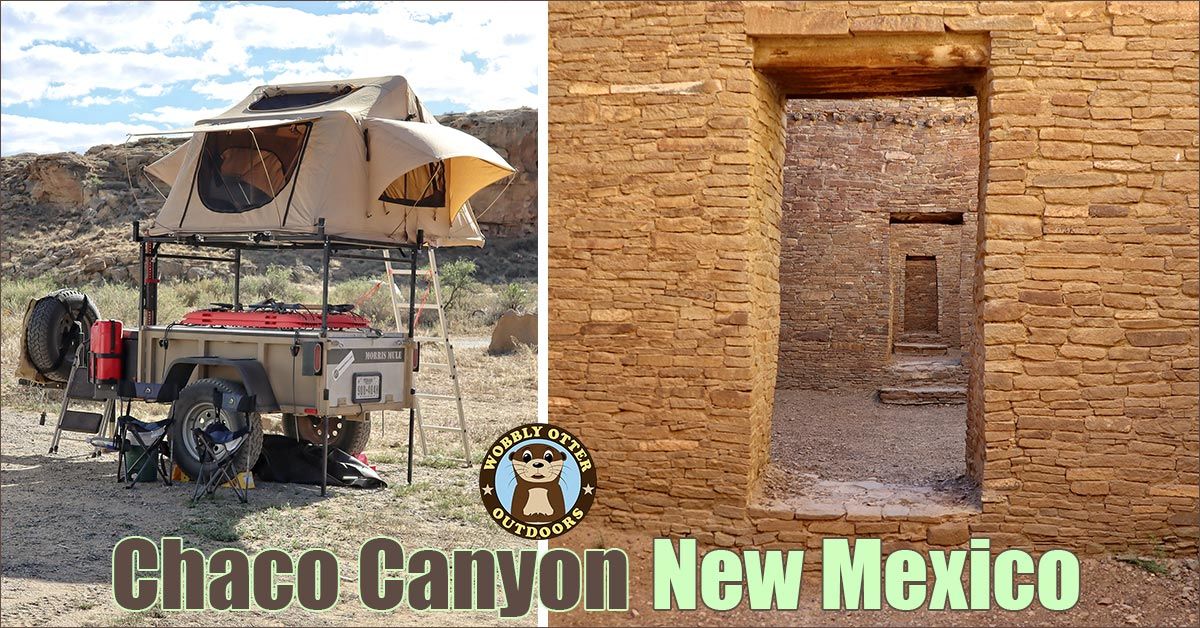Wobbly Otter Outdoors Videos
Chaco Canyon & A Bit of Overlanding
- Details
- Written by Cris
- Hits: 2806

This is the massive, rugged and beautiful Chaco Canyon.
We drop off pavement and take a scenic and dusty drive on New Mexico Highway 126. The last leg of today's journey is down 21 miles of rough gravel road. Camp is in Gallo Campground of the Chaco Culture National Historical Park. The video of this excursion is below.
Thank you for watching. We hope you'll subscribe to get the best Wobbly Otter adventures, how to's, and gear reviews delivered directly to you.
There is no rain in the forecast so we roll up the fly off the roof top tent inside the tent cover - like a burrito. This lets us open the roof windows for more ventilation and a view of the stars.
At supper time... It's a bit windy for cooking on George's (Morris Mule Trailer) tables, so the Firebox Stove goes on the fender, using the trailer as a wind break. Works pretty good.
During the full day in Chaco Canyon we visit three Ancestral Puebloan dwelling sites that you will see in this video: Pueblo Bonito, Chetro Ketl and Una Vida. Brochures, maps and trail guides are available at the visitor center.
Chetro Ketl is first. It is a multi-tier great house covering almost 3 acres and it has a great kiva. I can't get over how thick the walls are! The trail through Chetro Ketl is 1/2 mile.
We have our packed lunch at a Visitor Center picnic table with a raven. Una Vida Trail starts right by the visitor center. It is a small ruins with a nice little climb to see petroglyphs, and affords a nice view of the canyon. Una Vida trail, with trip up to see the petroglyphs, is 3/4 mile roundtrip.
The last site we see is the massive and incredible Pueblo Bonito. Pueblo Bonito is the most thoroughly investigated, visited and celebrated cultural site in Chaco Canyon. The Pueblo Bonito great house covers 3 acres, has approximately 800 rooms and has over 30 kivas. Parts of the pueblo were four and five stories high. The roundtrip trail through Pueblo Bonito is 3/4 mile.
Pueblo Bonito and Chetro Ketl both contain kivas - the round structures. Kiva is a Hopi word that roughly translates to ceremonial chamber.
The stone masonry walls are massive and beautifully laid. Removed by time and the elements is the plaster that covered all the walls when the dwellings were inhabited. Near the end of the video is a room with plaster wall to show what it would have looked like.
The large primary beam timbers of the roof and upper floor construction were set through holes in the wall. There are some places where the ends of the logs are still in the walls. One room in Pueblo Bonito has been preserved so you can see some of the original timbers and other roof/upper floor construction looked like.
References
Chaco Culture National Historical Park: https://www.nps.gov/chcu/index.htm
Pueblo Bonito: https://en.wikipedia.org/wiki/Pueblo_Bonito
Some of Our Gear Seen in This Video
If you'd like to support Wobbly Otter Outdoors all you have to do is watch our videos. Okay, here are some other ways to support us too.
Disclosure: Some of the product links on this page are affiliate links, and at no additional cost to you, we may earn a small commission if you make a purchase after clicking through the link. By using these links you help support Wobbly Otter Outdoors. Thank you.

 We appreciate your interest in, and
We appreciate your interest in, and